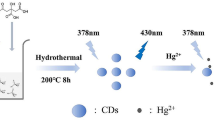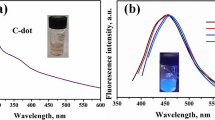Abstract
Developing carbon quantum dots with high throughput and quantum yields is important to boost their application in environmental detection. This study proposes nitrogen, sulfur co-doped carbon quantum dots as a fluorescent probe for mercury detection in an aqueous environment, which was synthesized by a facile and high-output tactic using methyl orange as a precursor for the first time. Results demonstrate that the obtained carbon quantum dots have a high selectivity, low detection limit of 237 nM, and fast response time, approximately 30 s, for trace mercury. The detection mechanism involves the synergistic action of static quenching, inner filter effect, and photo-induced electron transfer. Moreover, results show a high product yield (75.6%) and quantum yield (29.4%), which are higher compared to previous studies. These findings indicate that developed carbon quantum dots are promising sensing nanomaterials for mercury detection.




Similar content being viewed by others
References
Bhatt M, Bhatt S, Vyas G, Raval IH, Haldar S, Paul P (2020) Water-dispersible fluorescent carbon dots as bioimaging agents and probes for Hg2+ and Cu2+ ions. ACS Appl Nano Mater 3:7096–7104. https://doi.org/10.1021/acsanm.0c01426
Du X-Y, Wang C-F, Wu G, Chen S (2021) The rapid and large-scale production of carbon quantum dots and their integration with polymers. Angew Chem Int Ed 60:8585–8595. https://doi.org/10.1002/ange.202004109
He JH, Cheng YY, Yang T, Zou HY, Huang CZ (2018) Functional preserving carbon dots based fluorescent probe for mercury (II) ions sensing in herbal medicines via coordination and electron transfer. Anal Chim Acta 1035:203–210. https://doi.org/10.1016/j.aca.2018.06.053
Iravani S, Varma RS (2020) Green synthesis, biomedical and biotechnological applications of carbon and graphene quantum dots: a review. Environ Chem Lett 18:703–727. https://doi.org/10.1007/s10311-020-00984-0
Khan ME, Mohammad A, Yoon T (2022) State-of-the-art developments in carbon quantum dots (CQDs): photo-catalysis, bio-imaging, and bio-sensing applications. Chemosphere 302:134815. https://doi.org/10.1016/j.chemosphere.2022.134815
Kurniawan D, Sharma N, Rahardja MR, Cheng Y-Y, Chen Y-T, Wu G-X, Yeh Y-Y, Yeh P-C, Ostrikov KK, Chiang W-H (2022) Plasma nanoengineering of bioresource-derived graphene quantum dots as ultrasensitive environmental nanoprobes. ACS Appl Mater Interfaces 14:52289–52300. https://doi.org/10.1021/acsami.2c15251
Ma H, Guan L, Chen M, Zhang Y, Wu Y, Liu Z, Wang D, Wang F, Li X (2023) Synthesis and enhancement of carbon quantum dots from Mopan persimmons for Fe3+ sensing and anti-counterfeiting applications. Chem Eng J 453:139906. https://doi.org/10.1016/j.cej.2022.139906
Manikandan V, Lee NY (2022) Green synthesis of carbon quantum dots and their environmental applications. Environ Res 212:113283. https://doi.org/10.1016/j.envres.2022.113283
Priya TS, Chen T-W, Chen S-M, Kokulnathan T (2022) Bismuth molybdate/graphene nanocomposite for electrochemical detection of mercury. ACS Appl Nano Mater 5:12518–12526. https://doi.org/10.1021/acsanm.2c02215
Ren H, Li M, Liu Y, Zhao T, Zhang R, Duan E (2022) Nitrogen-rich carbon quantum dots (N-CQDs) based on natural deep eutectic solvents: Simultaneous detection and treatment of trace Co2+ under saline conditions. Sci Total Environ 811:152389. https://doi.org/10.1016/j.scitotenv.2021.152389
Song Z, Quan F, Xu Y, Liu M, Cui L, Liu J (2016) Multifunctional N, S co-doped carbon quantum dots with pH- and thermo-dependent switchable fluorescent properties and highly selective detection of glutathione. Carbon 104:169–178. https://doi.org/10.1016/j.carbon.2016.04.003
Wang Q, Zhang H, Yu D, Qin W, Wu X (2022) Ultra-sensitive and stable N-doped carbon dots for selective detection of uranium through electron transfer induced UO2+(V) sensing mechanism. Carbon 198:162–170. https://doi.org/10.1016/j.carbon.2022.07.036
Wu H, Pang LF, Fu MJ, Guo XF, Wang H (2020) Boron and nitrogen codoped carbon dots as fluorescence sensor for Fe(3+) with improved selectivity. J Pharm Biomed Anal 180:113052. https://doi.org/10.1016/j.jpba.2019.113052
Xu XY, Ray R, Gu YL, Ploehn HJ, Gearheart L, Raker K, Scrivens WA (2004) Electrophoretic analysis and purification of fluorescent single-walled carbon nanotube fragments. J Am Chem Soc 126:12736–12737. https://doi.org/10.1021/ja040082h
Xue S, Li P, Sun L, An L, Qu D, Wang X, Sun Z (2023) The formation process and mechanism of carbon dots prepared from aromatic compounds as precursors: a review. Small 17:2206180. https://doi.org/10.1002/smll.202206180
Zhao YN, Zou SY, Huo DQ, Hou CJ, Yang M, Li JJ, Bian MH (2019) Simple and sensitive fluorescence sensor for methotrexate detection based on the inner filter effect of N, S co-doped carbon quantum dots. Anal Chim Acta 1047:179–187. https://doi.org/10.1016/j.aca.2018.10.005
Acknowledgements
This work was supported by the National Natural Science Foundation of China (21976116 and 52161145409) and SAFEA of China (“Belt and Road” Innovative Exchange Foreign Expert Project, DL2023041004L). The authors acknowledge Researchers Supporting Project number (RSP2023R149), King Saud University, Riyadh, Saudi Arabia.
Funding
This work was financially supported by the National Natural Science Foundation of China (21976116 and 52161145409) and SAFEA of China (“Belt and Road” Innovative Exchange Foreign Expert Project, DL2023041004L).
Author information
Authors and Affiliations
Contributions
HR did material preparation, data collection, formal analysis, and writing—original draft. AL and JS were involved in investigation, writing—review, and editing. AAA, JSA, and MRA helped in methodology, validation, software, formal analysis. CW performed project administration, resources, writing—review, and editing.
Corresponding author
Ethics declarations
Conflict of interest
The authors declare that they have no conflict of interest.
Additional information
Publisher's Note
Springer Nature remains neutral with regard to jurisdictional claims in published maps and institutional affiliations.
Supplementary Information
Below is the link to the electronic supplementary material.
Rights and permissions
Springer Nature or its licensor (e.g. a society or other partner) holds exclusive rights to this article under a publishing agreement with the author(s) or other rightsholder(s); author self-archiving of the accepted manuscript version of this article is solely governed by the terms of such publishing agreement and applicable law.
About this article
Cite this article
Ren, H., Labidi, A., Sun, J. et al. Facile synthesis of nitrogen, sulfur co-doped carbon quantum dots for selective detection of mercury (II). Environ Chem Lett 22, 35–41 (2024). https://doi.org/10.1007/s10311-023-01660-9
Received:
Accepted:
Published:
Issue Date:
DOI: https://doi.org/10.1007/s10311-023-01660-9




